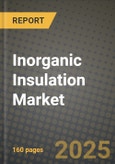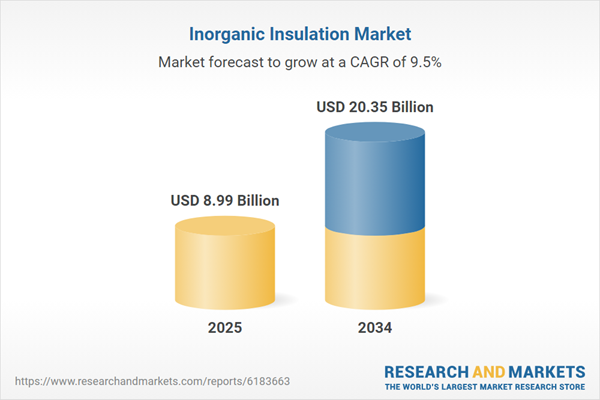Inorganic Insulation Market
The Inorganic Insulation Market spans mineral wool (stone and slag), glass wool, cellular glass, calcium silicate, expanded perlite/vermiculite, silica aerogels, and high-temperature ceramic fibers engineered for thermal, acoustic, and fire performance across buildings and industry. Top applications include building envelopes and HVAC; industrial process piping, boilers, and furnaces; power generation and refining; LNG/cryogenic systems; maritime and rolling stock; and data centers where continuity and fire integrity are paramount. Recent trends emphasize noncombustibility, low smoke toxicity, formaldehyde-free binders, higher recycled content, and Environmental Product Declarations to support whole-life carbon reporting. Digital takeoff tools, prefabricated pipe shells/blankets, and insulated panelized assemblies speed installation while reducing waste. Demand is driven by energy-efficiency codes, net-zero commitments, insurance-driven fire safety, electrification/heat-pump retrofits, and industrial decarbonization (steam losses, heat recovery). The competitive landscape features global building-materials majors, thermal-ceramics specialists, cryogenic solution providers, and aerogel innovators; differentiation rests on lambda stability at temperature, compressive strength, corrosion-under-insulation mitigation, hydrophobicity, and verified acoustics. Partnerships with EPCs and OEMs are expanding “spec-in” opportunities through system warranties and field technical services. Constraints include fiber health classifications (biopersistence), skilled-installer availability, price volatility in binders and energy, and the need for robust weatherproofing to prevent CUI. Overall, inorganic insulation is evolving from commodity rolls to engineered systems with documented performance across temperature ranges, delivering resilient fire safety and durable thermal/acoustic control with expanding roles in deep-retrofit buildings and high-temperature industrial decarbonization.Inorganic Insulation Market Key Insights
- Noncombustible by design: Mineral wool, cellular glass, and calcium silicate meet stringent fire and smoke criteria, positioning inorganic systems as the default in high-rise, façade, and critical-infrastructure use cases.
- Performance at temperature: Stable thermal conductivity, compressive strength, and thickness retention under heat/cycling favor inorganic materials for process industries, kilns, and turbine/HRSG enclosures.
- Moisture & CUI management: Hydrophobic treatments, breathable facings, and cellular glass vapor-tightness reduce under-insulation corrosion risk; detailing (jacketing, joints) is as critical as product choice.
- Acoustic advantages: Fiber structure and density tuning provide broadband sound attenuation for mechanical rooms, façades, and transport - supporting WELL/comfort targets in urban projects.
- Embodied-carbon transparency: EPDs, recycled cullet/slag inputs, and waste-heat smelting improvements differentiate bids as owners scrutinize Scope 3 and whole-life carbon.
- Installation productivity: Pre-shaped pipe sections, lamella boards, and modular blankets cut labor time, minimize offcuts, and improve consistency - vital amid skilled-trade shortages.
- Healthy-materials momentum: Low-VOC, formaldehyde-free binders and biopersistent fiber chemistries address occupational exposure and green-building submittals.
- System thinking wins: Pairing insulation with jacketing, vapor barriers, and supports under single warranties reduces failure modes and simplifies specification and QA.
- Aerogel and microporous niches: Ultra-thin, hydrophobic solutions solve space-constrained retrofits, cold service, and thermal bridges - commanding premiums where lifecycle value is clear.
- Digital specification: BIM objects, thermal models, and corrosion calculators accelerate “spec-lock,” while IoT temperature/ultrasonic monitoring supports predictive maintenance for industrial assets.
Inorganic Insulation Market Reginal Analysis
North America
Energy codes, utility incentives, and insurance scrutiny elevate noncombustible and high-R assemblies in commercial retrofits and data centers. Industrial demand stems from petrochemical, LNG, and food processing, with strong focus on CUI mitigation and cold-service vapor control. Contractors prioritize pre-formed pipe sections and single-source system warranties to de-risk schedules. Public and institutional owners increasingly require EPDs and low-VOC binders in submittals.Europe
Tightening building-safety and decarbonization policies - alongside façade fire regulations - favor mineral wool façades, ventilated systems, and cavity barriers. District energy, electrification, and industrial heat-recovery projects drive high-temperature specifications. Procurement emphasizes recycled content, verified acoustics, and circularity programs for offcut take-back. Installers adopt panelized façades and digital QA to meet labor and quality pressures across dense urban markets.Asia-Pacific
Rapid urbanization and industrial expansion underpin broad adoption from high-rise façades to complex process plants. Humid and coastal climates increase attention to jacketing, vapor management, and hydrophobic treatments. Local manufacturing scales mineral/glass wool competitively, while LNG and shipbuilding sustain cellular glass and perlite demand. Japan/Korea stress reliability and seismic detailing; Australia/India push deep-retrofit efficiency in commercial stock.Middle East & Africa
Harsh climates and large industrial complexes require durable, high-temperature systems with robust cladding against sand, UV, and thermal shock. LNG, refining, and desalination specify cellular glass, calcium silicate, and mineral wool with corrosion-control detailing. Fire-life-safety standards in towers and hospitality favor noncombustible façades. Training and certified installers are key differentiators for EPC schedules.South & Central America
Process industries - pulp & paper, mining, and food & beverage - drive brownfield upgrades targeting energy losses and worker safety. Commercial markets value acoustic and fire performance for mixed-use developments. Supply reliability, local conversion capacity, and technical service support weigh heavily in awards. Financing options and lifecycle maintenance plans help owners navigate capex constraints and skills variability.Inorganic Insulation Market Segmentation
By Product
- Rock Wool
- Glass Wool
By End-User
- Residential
- Commercial
- Industrial
Key Market players
ROCKWOOL Group, Owens Corning, Saint-Gobain ISOVER, Knauf Insulation, Johns Manville, URSA, Paroc, NICHIAS Corporation, Morgan Advanced Materials (Thermal Ceramics), Alkegen (Unifrax), Aspen Aerogels, Etex Group (Promat), Imerys, TechnoNICOL, KCC CorporationInorganic Insulation Market Analytics
The report employs rigorous tools, including Porter’s Five Forces, value chain mapping, and scenario-based modelling, to assess supply-demand dynamics. Cross-sector influences from parent, derived, and substitute markets are evaluated to identify risks and opportunities. Trade and pricing analytics provide an up-to-date view of international flows, including leading exporters, importers, and regional price trends.Macroeconomic indicators, policy frameworks such as carbon pricing and energy security strategies, and evolving consumer behaviour are considered in forecasting scenarios. Recent deal flows, partnerships, and technology innovations are incorporated to assess their impact on future market performance.
Inorganic Insulation Market Competitive Intelligence
The competitive landscape is mapped through proprietary frameworks, profiling leading companies with details on business models, product portfolios, financial performance, and strategic initiatives. Key developments such as mergers & acquisitions, technology collaborations, investment inflows, and regional expansions are analyzed for their competitive impact. The report also identifies emerging players and innovative startups contributing to market disruption.Regional insights highlight the most promising investment destinations, regulatory landscapes, and evolving partnerships across energy and industrial corridors.
Countries Covered
- North America - Inorganic Insulation market data and outlook to 2034
- United States
- Canada
- Mexico
- Europe - Inorganic Insulation market data and outlook to 2034
- Germany
- United Kingdom
- France
- Italy
- Spain
- BeNeLux
- Russia
- Sweden
- Asia-Pacific - Inorganic Insulation market data and outlook to 2034
- China
- Japan
- India
- South Korea
- Australia
- Indonesia
- Malaysia
- Vietnam
- Middle East and Africa - Inorganic Insulation market data and outlook to 2034
- Saudi Arabia
- South Africa
- Iran
- UAE
- Egypt
- South and Central America - Inorganic Insulation market data and outlook to 2034
- Brazil
- Argentina
- Chile
- Peru
Research Methodology
This study combines primary inputs from industry experts across the Inorganic Insulation value chain with secondary data from associations, government publications, trade databases, and company disclosures. Proprietary modeling techniques, including data triangulation, statistical correlation, and scenario planning, are applied to deliver reliable market sizing and forecasting.Key Questions Addressed
- What is the current and forecast market size of the Inorganic Insulation industry at global, regional, and country levels?
- Which types, applications, and technologies present the highest growth potential?
- How are supply chains adapting to geopolitical and economic shocks?
- What role do policy frameworks, trade flows, and sustainability targets play in shaping demand?
- Who are the leading players, and how are their strategies evolving in the face of global uncertainty?
- Which regional “hotspots” and customer segments will outpace the market, and what go-to-market and partnership models best support entry and expansion?
- Where are the most investable opportunities - across technology roadmaps, sustainability-linked innovation, and M&A - and what is the best segment to invest over the next 3-5 years?
Your Key Takeaways from the Inorganic Insulation Market Report
- Global Inorganic Insulation market size and growth projections (CAGR), 2024-2034
- Impact of Russia-Ukraine, Israel-Palestine, and Hamas conflicts on Inorganic Insulation trade, costs, and supply chains
- Inorganic Insulation market size, share, and outlook across 5 regions and 27 countries, 2023-2034
- Inorganic Insulation market size, CAGR, and market share of key products, applications, and end-user verticals, 2023-2034
- Short- and long-term Inorganic Insulation market trends, drivers, restraints, and opportunities
- Porter’s Five Forces analysis, technological developments, and Inorganic Insulation supply chain analysis
- Inorganic Insulation trade analysis, Inorganic Insulation market price analysis, and Inorganic Insulation supply/demand dynamics
- Profiles of 5 leading companies - overview, key strategies, financials, and products
- Latest Inorganic Insulation market news and developments
Additional Support
With the purchase of this report, you will receive:- An updated PDF report and an MS Excel data workbook containing all market tables and figures for easy analysis.
- 7-day post-sale analyst support for clarifications and in-scope supplementary data, ensuring the deliverable aligns precisely with your requirements.
- Complimentary report update to incorporate the latest available data and the impact of recent market developments.
This product will be delivered within 1-3 business days.
Table of Contents
Companies Mentioned
- ROCKWOOL Group
- Owens Corning
- Saint-Gobain ISOVER
- Knauf Insulation
- Johns Manville
- URSA
- Paroc
- NICHIAS Corporation
- Morgan Advanced Materials (Thermal Ceramics)
- Alkegen (Unifrax)
- Aspen Aerogels
- Etex Group (Promat)
- Imerys
- TechnoNICOL
- KCC Corporation
Table Information
| Report Attribute | Details |
|---|---|
| No. of Pages | 160 |
| Published | November 2025 |
| Forecast Period | 2025 - 2034 |
| Estimated Market Value ( USD | $ 8.99 Billion |
| Forecasted Market Value ( USD | $ 20.35 Billion |
| Compound Annual Growth Rate | 9.5% |
| Regions Covered | Global |
| No. of Companies Mentioned | 15 |









